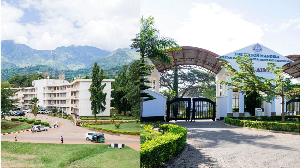Small and Medium Scale Enterprises (SMEs) or Small-Scale Enterprises (SSEs) form the bedrock of many developing countries including Ghana.
However, this assertion has been challenged as many SMEs across the globe are struggling to survive during this current Covid-19 times. That said, according to Sowah, Baan-Nuako et al (1993), SMEs span a wide range of activities in both the informal and formal sectors.
Typical areas include food processing, restaurants, chop bars, kiosk operators, roadside vendors, coco sellers, Waakye sellers, Kenkey sellers, and other agro-based industries, tailoring, bakeries, wood-related industries, shoemaking, and shoe repairs, manufacture and repair of metal products, electricians, plumbers, motor fitting and bodywork repairs, electronic repairs, black and gold-smiting, pottery, printing, pharmacy shops, among others.
This spread of activities across all sectors of the economy poses difficulties for the definition of small-scale industries. They could be defined according to size, or several employees or turnover or capital investment.
The Ghana Statistical Services (GSS) defines a small-scale industry in terms of the level of employment. This definition focuses on the number of employees. Any establishment with less than 10 employees is considered a small-scale. Steel and Webster (1991) use an employment cut-off of 30 workers to indicate small-scale enterprises. Baah-Nuako et al (1994) in a study on the Impact of Ghana’s Economic Recovery Program on Small Industries also defines small-scale industries as firms that employ less than 30 workers.
The now-defunct Ghanaian Enterprises Development Commission (GEDC) defines a small scale industry as one requiring a loan under its PAMSCAD program of not more than 2.5 Million Cedis or whose plant and machinery do not exceed 10 Million Cedis. Due to the problem of valuation, the use of plant and equipment usually poses problems and is mostly unreliable.
The World Bank Discussion Papers, Africa Technical Series (1994) defines Small and Medium-Sized Enterprises (SMEs) as those with an estimated value of total assets, excluding land, of up to $ 2 Million equivalent in 1988 constant prices.
Further desegregation is made for micro (less than 6 workers) very small (6 to 9 workers) and small (10 to 29 workers).
However, for this piece of research work, the definition of the National Board for Small Scale Industries (NBSSI), the government agency that oversees the activities of Small-Scale Enterprises (SSEs) will be adopted. It defines Small-Scale Enterprises (SSEs) as those, which have twenty-nine or fewer employees with a working capital excluding land and building not exceeding the cedi equivalent of US$ 100,000. These must be productive activities undertaken on a comparatively smaller scale for purposes of profit. Because of their contribution to economic development, income generation, and the use of local resources, small enterprises have enjoyed increased levels of support from government and donor agencies in recent times.
Support and assistance given to small-scale enterprises should lead to their growth through the generation of wealth, reduction in unemployment, improvement in services and should also promote general economic development.
Over the years, conventional sources of employment have been government establishments and a few media and large enterprises. The activities of these establishments, according to experts, have not expanded enough to accommodate the numerous job seekers on the market.
The history of Ghana’s economic development, since independence, suggests that its economic development lies in the hands of small and medium-scale manufacturers. There is an urgent need, therefore to encourage local entrepreneurs to face the challenges of national development and channel their efforts toward sustained economic growth (Galina 1998). However, Covid-19 has particularly made it difficult for many SMEs in Ghana to play a critical role in stimulating the economy as many SMEs have found it difficult to maintain staff, keep the levels of production intact, or support the economy at the usual pace it had done before the Coronavirus pandemic. Many are in deep financial crisis and will need urgent support from the Ghanaian government to survive or let alone play any meaningful role in Ghana's economic development efforts.
Literature Review:
According to Kilby (1965), although Africa has been the birthplace of important research on the concept of Small-Scale Enterprises (SSEs), SSEs, or Micro, Small and Medium-Sized Enterprises (MSMEs) have not been high on the development agenda of many African governments. Kilby however, fails to account for or explain the reasons for the poor performance of SSEs in many African states.
Earlier works by Szerewszeki (1965) indicate that, by the 1920s, Ghana’s economy had already been established as a producer and exporter of primary commodities and an importer of manufactured goods. That said, Szerewszeki fails to mention that, during the 1920s Ghana lacked the technical and entrepreneurial skills and the political will to encourage private businessmen to establish their enterprises or industries.
This is because, during this period, most of the goods produced in the country were imported from the United Kingdom, the United States, and other foreign countries. It was only until after independence in the 1960s that, the government began to make concerted efforts at developing the entrepreneurial capacity of SSE operators or owners. Kay (1972) attributes this, to the fact that industrialization was not part of the colonial scheme. For example, in the 1927 ten-year Development Plan, the entire allocation of £151,000 for the productive sector went to agriculture.
Kay’s analysis demonstrated the failure of the colonial administration to develop the technological sector of the economy as a means to foster growth.
Despite this, Romijin and Wide (1991) agree with Kay’s point of view and stresses that appropriate technologies will give SSEs or MSMEs an advantage in terms of greater efficiency in resource use and environmental effects relative to imported technologies (for example high agriculture input and high energy manufacturing).
But, Romijn and Wade also failed to recognize the role of fair trade in consolidating the efforts of the productive sectors of the economy, where through appropriate technologies, increased output of domestic SSEs or MSMEs could gain adequate access to international markets to compete fairly without undue restrictions on them. That said, perhaps, it is the quality of domestic production that makes it difficult for SSEs or MSMEs to fairly compete on the global market. Hence, the gap in the quality of production of domestic SSEs to meet international standards needs to be addressed.
Another comprehensive study by Thomi and Yankson (1985) identifies the main constraints facing SSEs or MSMEs in Ghana as inadequate credit, shortages in input supply, and depressed domestic demand for their products/services. Thomi and Yankson (1985) results show that most SSEs in Ghana do not offer much scope for substantial permanent wage employment, but that, they play a crucial role in training future entrepreneurs and providing opportunities for self-employment.
Regrettably, however, Thomi and Yankson failed to establish any link between the growth of SSEs, the availability of credit, and the quality of goods and services produced by domestic SSEs.
On credit, studies by Elkan (1987) and Liedholm and Mead (1987) agree on the fact that credit policy tends to discriminate against SSEs and established that, family finance is the main source of funding for most SSEs. They argued that the lack of effective credit policy, high administrative costs, and high default rates affect the flow of the needed credit to the sector.
Liedholm and Mead (1987), also found out that, SSEs activities appear to be increasing in absolute terms and at a faster rate than large-scale industries.
In terms of resource utilization, some results are striking. Liedholm and Mead revealed that SSEs generate more employment per unit of scarce capital resources than their large-scale counterparts. Capital productivity was also found to exceed that generated by large-scale industries.
However, Liedholm failed to give reasons why even though SSEs generate more employment per unit of scarce capital resources yet they receive less assistance for credit than large-scale firms.
Nevertheless, Bert Helmsing (1993) stresses that the current SSE debate concentrates on the immediate development problems and issues such as unemployment, structural adjustment impacts, and growth potentials in large industries but pays insufficient attention to the role of SSEs in the industrialization process in Africa. Earlier studies by Page (1979), confirm Helmsing’s view. Page observed that not much research has been done on the impact of specific policies on SSEs. This is partly because policymakers have neglected this aspect of SSE development. The only policies directly affecting SSEs were the indigenization efforts of African governments. Industrial and trade policies have discriminated against smaller firms resulting in the poor performance of SSEs in Africa.
Page (1978) reports that foreign trade regimes, which employ rationing systems favour large enterprises as against small ones but did not provide adequate reasons for this line of thinking pursued by African governments.
William Steel (1979) argues that the exclusion of small-scale enterprises from the import allocation scheme in Ghana in the 1970s contributed to supply uncertainties. Steel further argues and presents a long-standing practitioner view on policy biases, market distortions, and other factors, which pre-empt or prevent the growth of SSEs. Some of the factors he mentioned include inadequate opportunities and resources for SSEs, entrepreneurs’ inability and unwillingness to develop at a fast rate, unfavourable business environment, and the lack of incentives and other important facilitating institutions.
On the effects of structural adjustment policies on SSEs, Steel stresses that trade liberalization may result in a flood of competing imports, which would seriously reduce the market share of domestic SSEs production. On the contrary, Stewart, Thomas, and de Wilde (1990) are of the view that many contrasting ideas have developed in the case of short- and medium-term effects of structural adjustment policies on SSEs. For example, Dawson et al (1900) maintain that a strong reduction in the overvaluation of the exchange rate (through devaluation) would ensure that imported products would become sufficiently dear to prevent such an effect.
Osei et al (1990) also argue that the extent of devaluation on the input of SSEs depends on the extent to which SSEs themselves are relying on imported inputs for producing either for the domestic or export market. They predicted that these effects would be overshadowed by demand contraction resulting from the implementation of these skewed programs against SSEs. They see the importation of inputs as among the factors causing the poor performance of SSEs in Ghana. That being said, they are more optimistic about the success of small-scale enterprises in Ghana and do indicate that SMEs will continue to play a pivotal role in Ghana's economic development efforts.
According to Bagachawa (1990), in Tanzania, foreign exchange control has been relaxed in favour of SSEs. He stresses that the Ghanaian government intends to operate the foreign exchange bureaux similarly in Ghana. Hence, he attributes the poor performance of SSEs partly to the overvaluation of the local currency. Nonetheless, his study ignores the impact of non-monetary factors on the poor performance of SSEs in Ghana.
Aryeetey (1991) however, believes that SSEs fail to thrive owing to inappropriate credit policies. He shows that the share of SSEs in domestic credit has consistently declined between 1985 and 1990 and this situation will continue if action is not taken to improve the current state of affairs.
He indicated that, out of the 100 small enterprises he studied, which had a current and or saving accounts for quite some time, only one (1) received the full amount of credit it had applied for. Seventy-three (73%) percent of the SSEs had their applications turned down outright for various reasons such as the lack of acceptable collateral security.
He also attributed the reluctance of commercial banks to grant loans to SSEs to high risk, high default rates, and higher per-unit administrative costs and recommends the setting up of guaranteed schemes to deal with the credit problems of various SSEs in the country. Aryeetey’s recommendations imply that the non-banking financial institutions like EMPRETEC Ghana Foundation which assist SSEs with credit sourcing, training, networking for foreign partners are worth funding by the government, international financial institutions, and NGOs to enable them to deliver better services to SSEs.
Policy Issues on Micro, Small and Medium-Sized Enterprises in Ghana
Government’s Industrialization Policy:
The industrialization policy pursued by Ghana after independence depended heavily on direct Government investment and involvement in the promotion and development of large-scale state-owned enterprises. Investment policy was largely based on import substitution, which relied heavily on the importation of raw materials, intermediate and capital goods. The economic decline in the 1970s generated a balance of payments deficits and severe foreign exchange shortages.
To solve the production and deteriorating foreign exchange problems, controls, and regulatory policies were introduced which adversely affected the private sector, creating disincentives for domestic production and exports. This further aggravated the acute problem of foreign exchange scarcity leading to shortages of critical production inputs and consequently causing a further decline in economic growth. However, over the years, there has been great improvement in the economy where these economic indicators have changed - that is, the economy has been more stable, foreign exchange reserves have improved and balance of payment deficits are manageably earning the country a middle-income status. What is left though, is how do these critical changes reflect in the living conditions of the general populace - particularly the poor and the vulnerable groups in the Ghanaian society.
Role of MSMEs in the Ghanaian Economy:
The government acknowledges that, due to its inherent characteristics, the Micro, Small and Medium-Sized Enterprises (MSME) sector can contribute substantially to reducing the high unemployment rate and increase the growth of the economy with the support of an enabling policy environment. The government recognizes the following as being some of the economic and social benefits of (Micro, Small and Medium-Sized Enterprises) MSMEs in the country;
1. Significant contribution to the economy in terms of output of goods and services.
2. Creation of jobs at a relatively low capital cost.
3. Improvement of forwarding and backward linkages between economically, socially, and geographically diverse sectors.
4. Provision of opportunities for developing and adopting appropriate technologies.
5. Offering an excellent breeding ground for entrepreneurship and managerial talents, the critical shortage of which is often a great handicap to economic development.
6. Development of a pool of skilled and semi-skilled workers.
7. Acting as ancillaries to large scale enterprises.
8. Flexible adaptation to market fluctuations.
8. SMEs lending themselves to development policies that favour decentralization and rural development.
9. Alleviating the negative consequences of structural adjustment programs and policies.
10. Increasing savings and investment by local entrepreneurs and encouraging the use of local resources, thus leading to the more effective use of scarce capital resources.
11. Establishing the legal framework for MSMEs to operate efficiently.
Government Policy on MSMEs Development
According to Sowah, Baah-Nuako et al (1993), the rapid growth in the population (which now stands at about 28 million) and labour in Ghana and the reduction in employment in the formal sector have given concern to policymakers. The principal concern has been with the problems of unemployment in both the urban and rural areas. The Ghanaian government has realized that, if positive interventions are adopted in the Micro, Small, and Medium-Sized Enterprises Sector (MSME), the unemployment level can significantly be reduced.
The Micro, Small and Medium-Sized Enterprises sector in the past has demonstrated these capabilities by absorbing significant portions of the 60, 000 civil servants who were re-deployed in 1993. And in this current dispensation of 2020, MSMEs can still contribute significantly to reducing the levels of unemployment in the country.
Thus, in the general scheme of affairs, the opportunities for employment generation through MSMEs depends on the growth of the sector, which in turn depends on the improvement in the quality of products produced, management and marketing, accessibility to institutional credit, raw materials, the policy environment and the opportunities for improvement in skills, competencies, available infrastructure and improved technologies.
Government policy documents mainly looked at three critical areas for enhancing the employment generation capabilities of Micro, Small, and Medium-Sized Enterprises in Ghana. These are:
1.The enabling environment
2. Micro, Small and Medium-Sized Enterprises Finance
3. Non-Financial Programs
a) The Enabling Environment:
According to the government policy paper of 1998 and the current 2019 Government Draft policy document on achieving economic growth through Micro, Small and Medium-Sized Enterprises Development in Ghana, the enabling environment covers government policy framework, market development, inter-industry linkages, and technology development.
It has been found that the best environment for the development of MSMEs is minimum regulations, a clear legal framework, adequate infrastructure facilities, equal incentives, and opportunities for all enterprises. The government has initiated several measures including institutional support and the enabling macro policies to enhance among others, the District Assemblies (DAs) to plan infrastructure and other development programs, which will facilitate private entrepreneurship.
Despite government effort, there are still problems in the enabling environment, which tend to inhibit the development of the sector. These are the unfavourable climate, poor and inadequate infrastructure (i.e. electricity, water, land, roads, telecommunication), inaccessibility of information, the use of old, crude and rudimentary technology, weak external markets, absence of sufficient ancillary linkages between Micro, Small, and Medium-Sized and Large Scale Enterprises.
The 1998 government policy paper on SMEs and the current 2019 Final Draft policy document on MSMEs or SSEs, recommended the following policies to alleviate the problems faced by SSEs or MSMEs with regards to the enabling environment:
1. Improvement of the investment climate through continuous divestiture of state-owned enterprises and the review of the tax systems.
2. Improvement in infrastructure by involving local private business associations, in decision-making on infrastructure requirements at the district and local levels.
3. Enhancing marketing opportunities for SSEs or MSMEs by developing comprehensive marketing programs to expand demand for made in Ghana products.
4. Improvement of local input sourcing through quality improvement measures for locally made intermediate products and provision of attractive incentive packages to larger firms or MSMEs or SSEs.
5. Improvement of the technological base of industry and effective dissemination of technology information.
b) Micro, Small, and Medium-Sized Enterprise Financing.
Micro, Small and Medium-Sized Enterprises (MSMEs) rely on banks, non-banking financial institutions, government and non-governmental agencies, informal financial systems, and their sources to finance their operations. In their efforts to seek credit from these sources they encounter constraints such as negative perception of MSMEs by banks, weak credit delivery system, stringent lending requirements, inadequate loanable funds, and unresponsiveness of bank’s structure and orientation of SMEs or SSEs or MSMEs lending.
The Government policy paper of 1998 on Small and Medium-Sized Enterprises (SMEs) and current 2019 Final Draft policy on Micro, Small Medium Enterprises (MSMEs) development, recommends the following solutions to alleviate these problems:
1. Improvement of the perceptions of Banks of MSMEs or SMEs by strengthening the structure and operations of SMEs or MSMEs through training and the cultivation of a savings culture.
2. Improvement of credit delivery to SSEs or SMEs or MSMEs by training banks and other Credit officers in small loan appraisals and using NGOs and other non-bank institutional intermediaries in credit evaluations.
3. Improving lending conditions to MSMEs through the application of alternative forms of security such as credit and savings records of entrepreneurs and the use of credit reference bureaus.
4. Making adequate funds available for SSEs or SMEs or MSME lending through the establishment of a special Small Industries Financing Companies (SIFICOs).
5. Improving Legal governing MSMEs development.
6. Re-orientation of banks structure and operations to be responsive to SSEs or MSMEs or SMEs lending by organising conferences and workshops, seminars, etc. to develop bank commitment to SSEs or SMEs or MSME lending.
c) The Non-Financial Assistance Programs.
A third requirement for the emergence of a new strategy for the growth of existing MSMEs or SSEs or SMEs besides enhancing the policy environment and adequate financing is the provision of non-financial assistance to this sector. Among others, non-financial assistance involves entrepreneurship development, improvement in managerial and technical skills, marketing and extension services as well as technology transfer.
The delivery of non-financial assistance program to SSEs or SMEs or MSMEs has been constrained by the following factors among others:
i) Lack of capital.
ii) Lack of management skills for entrepreneurs.
iii) Ineffective delivery systems.
iv) Inadequate budget support from government institutions in assisting SSEs or MSMEs or SMEs.
v) Low involvement of the private sector and
vi) The lack of an integrated approach toward support programs for SSEs or MSMEs or SMEs.
vi) An efficient legal framework to support the activities of SSEs or SMEs or MSMEs.
To overcome these constraints the Government recommended the following measures:
1. Promotion of more dynamic enterprise culture.
2. Improvement of management skills of MSMEs or SSEs or SMEs involves organizing targeted and specific management programs for SMEs and their associations.
3. Improving the delivery of non-financial services.
4. Promoting the effectiveness and complementary efforts of government institutions supporting SSEs by improving the manpower base and financial resources of SSEs support institutions to enable effective coordination, monitoring, and evaluation.
5. Encouraging private sector involvement in SSEs or MSMEs development by strengthening existing MSME associations and providing non-financial assistance programs, which are holistic, integrated, and cost-effective.
6. Establishing a well functioning legal framework for MSMEs or SSEs or SMEs.
Strategies and National Program for Micro, Small, and Medium-Sized Financial Institutions in Ghana.
According to Ernest Aryeetey (1991), it is generally assumed by policymakers in developing countries including, Ghana that, there is a highly unsatisfied demand or significant potential demand for credit by small-scale borrowers. To satisfy this need, there is an urgent call for a strategic national program for Small, Micro, and Medium-Sized Enterprises financing.
The current program for the development of microfinance institutions in Ghana is being spearheaded by NGOs such as Technoserve Incorporated and Isodec in the southern sector and Action Aid in the northern sector as part of the Micro Finance Institutions Action Research Work. The programs and activities of these NGOs are aimed at the following:
1. Enhance financial integration.
2. Build institutional capacities.
3. Develop an information base in micro-financing.
In this regard, the following mechanisms have been identified by the Micro Finance Institutions Action Research Network as essential for the attainment of their goals.
1. Developing linkages between informal and formal institutions.
2. Establishing an apex body to coordinate microfinance.
3. Organizing fora, symposia, and seminars to educate various stakeholders on the importance of MSMEs to national development.
4. Meeting the training needs of Micro Finance Institutions (MFIs). The training needs identified by MFIs include financial analysis, loan delinquency, prudence and accountability, meeting central bank requirements and regulations, training for board members, field staff and targeted groups (Dennis 1998).
Conclusion:
This study has shown the tremendous role played by SMEs, SSEs, MSMEs in Ghana's economic development efforts. SMEs, have provided jobs to a majority of the population, it has generated scarce foreign exchange for the country, it has helped in promoting micro and
macroeconomic stability, tax revenue from registered SMEs, skills development, improved managing capabilities of owners of MSMEs, and consolidated the production efforts of large Scale Enterprises.
Unfortunately, in the past (colonial period), SMEs, were not given prominence in the industrial development agenda of many governments on the African continent. However, over the years, it has become clear how pivotal SSEs or MSMEs or SMEs are to the development efforts across nations in Africa. It is hoped that this renewed interest in SMEs will be sustained. That being said, there also the great challenge of the impact of the current Coronavirus pandemic on many economies in the developing world and as well as economies of advanced nations. But one is hopeful that, despite this situation, SSEs, MSMEs, SMEs will prevail and strongly contribute to making the Ghanaian economy buoyant and robust for many generations to come.
Opinions of Monday, 19 October 2020
Columnist: Kordson Ayrakwa















